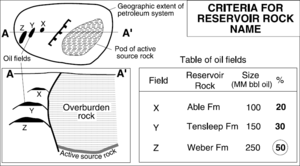Difference between revisions of "Petroleum system naming"
FWhitehurst (talk | contribs) m (removed Category:Petroleum systems; added Category:Petroleum system using HotCat) |
Cwhitehurst (talk | contribs) m (added Category:Treatise Handbook 3 using HotCat) |
||
| (6 intermediate revisions by 3 users not shown) | |||
| Line 6: | Line 6: | ||
| part = Traps, trap types, and the petroleum system | | part = Traps, trap types, and the petroleum system | ||
| chapter = Petroleum systems | | chapter = Petroleum systems | ||
| − | | frompg = 3- | + | | frompg = 3-7 |
| − | | topg = 3- | + | | topg = 3-8 |
| author = Leslie B. Magoon, Edward A. Beaumont | | author = Leslie B. Magoon, Edward A. Beaumont | ||
| link = http://archives.datapages.com/data/specpubs/beaumont/ch03/ch03.htm | | link = http://archives.datapages.com/data/specpubs/beaumont/ch03/ch03.htm | ||
| Line 14: | Line 14: | ||
| isbn = 0-89181-602-X | | isbn = 0-89181-602-X | ||
}} | }} | ||
| − | A unique designation or name is important to identify a person, place, item, or idea. As geologists, we name rock units, fossils, uplifts, and basins. The name for a specific petroleum system separates it from other [[petroleum systems]] and other geologic names. | + | A unique designation or name is important to identify a person, place, item, or idea. As geologists, we name rock units, fossils, uplifts, and basins. The name for a specific [[petroleum]] system separates it from other [[petroleum systems]] and other geologic names. |
==Parts of a petroleum system name== | ==Parts of a petroleum system name== | ||
| − | [[file:petroleum-systems_fig3-1.png|thumb|{{figure number|1}} | + | [[file:petroleum-systems_fig3-1.png|thumb|300px|{{figure number|1}}How a reservoir rock name is selected.]] |
The name of a [[petroleum system]] contains several parts that name the hydrocarbon fluid system: | The name of a [[petroleum system]] contains several parts that name the hydrocarbon fluid system: | ||
| Line 29: | Line 29: | ||
==Level of certainty== | ==Level of certainty== | ||
| − | A [[petroleum system]] can be identified at three levels of certainty: known, hypothetical, and speculative. The level of certainty indicates the confidence for which a particular pod of mature [[source rock]] has generated the hydrocarbons in an accumulation. At the end of the system's name, the level of certainty is indicated by (!) for known, (.) for hypothetical, and (?) for speculative. | + | A [[petroleum system]] can be identified at three levels of certainty: known, hypothetical, and speculative. The level of certainty indicates the confidence for which a particular pod of mature [[source rock]] has generated the hydrocarbons in an [[accumulation]]. At the end of the system's name, the level of certainty is indicated by (!) for known, (.) for hypothetical, and (?) for speculative. |
The table below indicates how the level of certainty is determined. | The table below indicates how the level of certainty is determined. | ||
| Line 57: | Line 57: | ||
* [[Petroleum system: geographic, stratigraphic, and temporal extent]] | * [[Petroleum system: geographic, stratigraphic, and temporal extent]] | ||
* [[Petroleum system size]] | * [[Petroleum system size]] | ||
| − | |||
==External links== | ==External links== | ||
| Line 65: | Line 64: | ||
[[Category:Traps, trap types, and the petroleum system]] | [[Category:Traps, trap types, and the petroleum system]] | ||
| − | [[Category:Petroleum | + | [[Category:Petroleum systems]] |
| + | [[Category:Treatise Handbook 3]] | ||
Latest revision as of 18:35, 25 January 2022
| Exploring for Oil and Gas Traps | |

| |
| Series | Treatise in Petroleum Geology |
|---|---|
| Part | Traps, trap types, and the petroleum system |
| Chapter | Petroleum systems |
| Author | Leslie B. Magoon, Edward A. Beaumont |
| Link | Web page |
| Store | AAPG Store |
A unique designation or name is important to identify a person, place, item, or idea. As geologists, we name rock units, fossils, uplifts, and basins. The name for a specific petroleum system separates it from other petroleum systems and other geologic names.
Parts of a petroleum system name
The name of a petroleum system contains several parts that name the hydrocarbon fluid system:
- The source rock in the pod of active source rock
- The name of the reservoir rock that contains the largest volume of in-place petroleum
- The symbol expressing the level of certainty
Figure 1 an example of a petroleum system name and its parts.
Level of certainty
A petroleum system can be identified at three levels of certainty: known, hypothetical, and speculative. The level of certainty indicates the confidence for which a particular pod of mature source rock has generated the hydrocarbons in an accumulation. At the end of the system's name, the level of certainty is indicated by (!) for known, (.) for hypothetical, and (?) for speculative.
The table below indicates how the level of certainty is determined.
| Level of Certainty | Criteria | Symbol |
|---|---|---|
| Known | A positive oil-source rock or gas-source rock correlation | (!) |
| Hypothetical | In the absence of a positive petroleum-source rock correlation, geochemical evidence | (.) |
| Speculative | Geological or geophysical evidence | (?) |
See also
- Petroleum system
- Petroleum system identification
- Petroleum system: geographic, stratigraphic, and temporal extent
- Petroleum system size
